Monthly Archives: January 2014
Senior Exercises
Posted by National Care Planning Council
There are very few people in this world that can say “I get the recommended amount of exercise,” the Elderly are no exception. The Center for Disease Control recommends the elderly exercise at least 2 days per week. [1] The intensity in which you partake in exercise is according to your physical limitations if any, however as you exercise your intensity may increase over time. Getting exercise at any age can help with more graceful aging, aid in digestion and help prevent falling.
- Stretching exercises: doing daily stretches can assist in a better range of motion and can assist in easing with other physical activity. Yoga is a good balance between stretching and exercise.
- Balancing exercises: leg exercises can assist in strengthening leg muscles to avoid slips, trips and falls. Great exercises to help are listed shown below: Calf Raises, Squats (if you have knee issues, take it slowly or eliminate it all together).
- Endurance exercises: These are exercises that get your heart rate up but don’t have to be extremely strenuous such as walking, jogging, swimming, etc.
- Strength exercises:
Physical Health Benefits of Exercise and Fitness Over 50
- Exercise helps older adults maintain or lose weight. As metabolism naturally slows with age, maintaining a healthy weight is a challenge. Exercise helps increase metabolism and builds muscle mass, helping to burn more calories. When your body reaches a healthy weight, your overall wellness will improve. [2]
- Exercise reduces the impact of illness and chronic disease. Among the many benefits of exercise for adults over 50 include improved immune function, better heart health and blood pressure, better bone density, and better digestive functioning. People who exercise also have a lowered risk of several chronic conditions including Alzheimer’s disease, diabetes, obesity, heart disease, osteoporosis, and colon cancer. [2]
- Exercise enhances mobility, flexibility, and balance in adults over 50. Exercise improves your strength, flexibility and posture, which in turn will help with balance, coordination, and reducing the risk of falls. Strength training also helps alleviate the symptoms of chronic conditions such as arthritis. [2]
Mental Health Benefits of Exercise and Fitness Over 50
- Exercise improves your sleep. Poor sleep is not an inevitable consequence of aging and quality sleep is important for your overall health. Exercise often improves sleep, helping you fall asleep more quickly and sleep more deeply. [2]
- Exercise boosts mood and self-confidence. Endorphins produced by exercise can actually help you feel better and reduce feelings of sadness or depression. Being active and feeling strong naturally helps you feel more self-confident and sure of yourself. [2]
- Exercise is good for the brain. Exercise benefits regular brain functions and can help keep the brain active, which can prevent memory loss, cognitive decline, and dementia. Exercise may even help slow the progression of brain disorders such as Alzheimer’s disease. [2]
Suggested Exercises
Stretches
These are links to some easy stretches you may be able to do alone and some assisted, I chose these sites because they have pictures.
http://www.nhs.uk/Livewell/fitness/Pages/flexibility-exercises-for-older-people.aspx
http://edinformatics.com/health_fitness/improve_flexibility.htm
Calf Raises
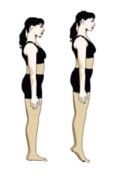
- Picture and Instructions from SkimZone
-Stand flat on the ground or with your toes on a ledge, heels hanging off.
-Push up onto your toes as high as you can while remaining stable.
-Use a wall or object for support if needed.
-Do one set using both feet, then another set, per foot, using just one foot.
-Challenge: hold a light weight in each hand.
Squats
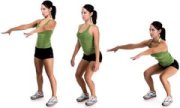
- Picture and Instructions from LesFemmeSportive
For squats stand with your legs shoulder width apart and drop down so you are imitating the “sitting in a chair” position.
Shoulder Press
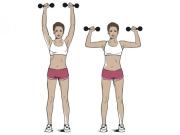
- Picture and Instructions from Womens Health Mag
–Stand with a dumbbell in each hand. Bend elbows at 90 degrees with the dumbbells at ear level and palms facing forward.
-Straighten your arms and press the dumbbells toward the ceiling, then return to the start.
Jab Cross
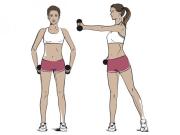
- Picture and Instructions from Womens Health Mag
-Stand with your feet hep-width apart, knees slightly bent, a weight in each hand and elbows bent into sides, palms facing.
-With your abs contracted, twist your torso to the right, punch your left arm straight across your body to the right. Next twist your torso to the left and punch your right arm the same way.
Lateral Raises

- Picture and Instructions from Lean It Up
-Hold two dumbbells at your side with a neutral grip. Keep your arm straight and powerfully raise your right arm sideways until it reaches shoulder height.
-Hold for .5s, lower to start, and perform with your left arm. Repeat.
Massages are also a great muscle and stress relief and help strengthen and ease pain, aid in circulation and can be done while assisting an elderly person with stretching exercises.
You’re never too old to exercise and you don’t have to be sweating buckets to consider it exercising. Of course you should consult with your Doctor before creating an exercise regiment as they will have the best advice for you.
Seated Shoulder Shrugs
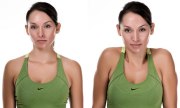
- Picture and Instructions from Summit Spine Care
Start by looking straight ahead. Slowly raise both shoulders up. Hold for five seconds, then return to starting position. Do ten repetitions. This is a good exercise to do during work, especially if you have to keep your head in a steady position for extended periods, as in working at a computer. Do this exercise every half hour to prevent neck strain.
Neck Rotation

- Picture and Instructions from Summit Spine Care
Start by looking straight ahead. Slowly turn your head to the left. Hold for ten seconds, then return to starting position. Then, slowly turn your head to the other side. Hold for ten seconds. Return to starting position. Do ten repetitions. This is a good exercise to do during work, especially if you have to keep your head in a steady position for extended periods, as in working at a computer. Do this exercise every half hour to prevent neck strain.
Advice from Others:
Mary A. Croson: I’m a certified nursing assistant, who has worked in LTC and currently go to individuals homes to take care of them. You need start off slow with exercise perhaps by doing just range of motion with arms and legs. Also doing sitting and standing exercises. Just getting them to move and do what they are able too is a good start. For example tossing a small soft ball back and forth is one way to make it fun!
John Berak: When she feels up to it, mom likes to “go out”……..hair, drive, lunch…….expensive but seeing her walk, eat and interact is worth it……
LuElla D. Brown: Hi, I bought my Mom a squeeze ball for her hands, and a step-n- tone . She sits in her chair and just pump her legs on the steps. I found this at Walgreens. It’s great .
Cheryl Tomco: You may want to check out S.A.I.L. I believe it stands for Staying Active In Life. My mother at 84 started going to the classes 4 years ago after physical therapy for a knee injury when it was just getting started in our town. Now there seems to be an abundance of the classes held at the Senior Center and churches. Chair exercises, light weights, stretching, squeezing small exercise balls with legs and hands, and walking while turning their heads for balance and 5 minute free walks. The classes are designed for the elderly and those recovering from surgery. An added benefit is the social aspect. My mother goes 5 days a week. Oh and it is free! All the instructors are volunteers!
James ‘jb’ Robinson: I work in cardiology and face this every day. Our physiologists want 30 minutes of daily activity. It can be broken up into 10-15 minute blocks. The idea is to be active. Just active. Anyway active. So we get creative. Ride an excercycle during a tv show, or March circles around the couch for the show. Or how about doing chair exercises during the show and walking around the chair during the ads? Put on music and dance while cooking. Don’t have the paper delivered, but walk to the corner everyday you want news. I have a whole stack of them…..
References:
[1] http://www.cdc.gov/physicalactivity/everyone/guidelines/olderadults.html
[2] http://www.helpguide.org/life/senior_fitness_sports.htm
Written by Valerie Michel Buck
Posted in Senior Health and Wellness, Senior Lifestyle
Tags: calf raises, d&s, dependence in elderly years, divine & sexy, divine and sexy, divine&sexy, divineandsexy, elder care services, elderly, elderly working, endorphins, exercise, facebook advice, jab cross, lateral raises, national care planning council, senior brain health, senior exercise, senior health, senior wellness, seniors, seniors veterans alliance, service to the elderly, should press, social media advice, squats, stretches, veterans